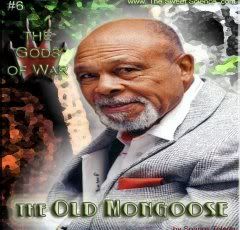He was unbelievable. Since I gather from your posts that you are a knowledgeable hard core fan and avid historian, I thought you might enjoy Springs Toledo's take on the incredible Archie Moore.
----------------------
2 Parts cause of the character max.
The Sixth God of War: Archie Moore
By Springs Toledo
“Time is a strange brew.”
~ Archie Moore
Archie Moore may have needed smelling salts to revive him after hearing that he was finally getting a crack at the light heavyweight title after 160 professional bouts. He was lucky he didn’t break his hip when he fell. The “Old Mongoose” turned thirty-six years old four days before he stepped into the ring against champion Joey Maxim during the Yuletide season of 1952.
Moore was aging all right, but he was an aging puncher, and that meant something. His legs were stuck in cement, which only made it easier to plant his feet and launch the dynamite in his fists. Do you remember your grandfather’s vice-grip of a handshake? Men get stronger as they age.
Moore was always a powerful fighter and partially because of that, an avoided fighter. He had been ranked as a middleweight from 1940 through 1944 and ranked as a light heavyweight for the next eight years. Two of his most dangerous opponents had already retired by the time he fought Maxim: Charley Burley in 1950 and Eddie Booker in 1944. Neither of them was able to get a world title shot and all three had to take jobs outside of boxing at one time or another: Burley at an aircraft plant, Booker as a red cap porter, and Moore as a night watchman. “I am often asked why, when both Burley and Booker beat me, neither one got to the top whereas I did,” the introspective Moore said, “Well, I guess it’s the way I sized things up. I felt I had two opponents –other boxers and Father Time.” Discouragement, he said, “can KO a boxer even before he has a chance to step into the ring.”
Moore may have had a main event against Father Time, but he never forgot those preliminary brawls early in his career. After a three month, seven fight jaunt in Australia in 1940 he dropped anchor in California at the age of twenty-three and joined the round-robin ranks of other great black boxers then campaigning on the west coast. Moore and the set remembered as ‘Murderers’ Row’ fought among themselves like lions for peanuts not far enough from the San Diego Zoo. All told, Archie Moore, Charley Burley, Eddie Booker, Jack Chase, Lloyd Marshall, Tiger Wade, Bert Lytell, as well as Holman Williams and Cocoa Kid fought each other 79 times. Archie’s record against them was 10-5-3 with 4 knockouts, which was about as good as it got.
Those internecine wars furnished each of them with a wealth of experience but their purses weren’t even enough to furnish a house …and they opened no doors.
A frustrated Charley Burley hung up the gloves and took a job as a garbage man for the city of Pittsburgh. Eddie Booker retired after an eye injury got progressively worse. Bert Lytell had his last fight when he was just twenty-seven years old. In 1951 he was at Grossinger’s gym in New York sparring with world middleweight champion Randy Turpin before Turpin’s rematch with Sugar Ray Robinson. Jack Chase, Lloyd Marshall, Holman Williams, Tiger Wade, and Cocoa Kid retired in their mid-30s due to fading skills, a devastating loss, or both.
Bitterness was a contagion for ignored fighters like the Mongoose and Murderers’ Row. Perhaps Moore’s greatest triumph was an emotional one. He had developed ulcers that ruptured the day after a brutal bout with Booker and landed him in the hospital for thirty-eight days. He was close to death. After self-diagnosing the spiritual causes of his ailment, he picked up a mirror and saw a face etched with tension. It was the face of millions of African American men seething under the surface, held down by invisible chains. Moore found that he was holding on to negative feelings in his heart and it had done a number not only on his health, but on his character. He wrote his own prescription for healing remedies that predated the New Age movement by three decades –he listened to jazz, learned to take therapeutic naps, mastered his pseudo-scientific theories of “breathology,” “escapism,” and “relaxism” and overcame what ailed him.
It was an achievement that stands as a monument to inspire us all. Moore went deep into an internal cave and battled the dragons lurking in his own humanity. What emerged was a philosopher-king who took hold of a grand mission and slung it on his back. He would not only honor an old promise made to his aunt to refrain from drinking, smoking, or “doing anything shameful in the ring,” he also made a new one to himself. Before George Foreman was even born, Archie Moore would ignore time and its creaking warnings and force his way through the gates of a kingdom that was rightfully his.
“I know I can beat Maxim,” he told reporters, “I always did believe I could beat him.”
A.J. Liebling agreed. Moore reminded him of “a supreme exponent of bel canto who sees himself crowded out of the opera house by a guy who can only shout.” The perennial top contender took matters into his own hands and began writing letters to sports editors all over the country. “I pleaded, I cursed,” he remembered, “I demanded a shot at Maxim's crown.” Joey Maxim’s manager was the go-to man and it just so happened that Maxim’s manager was Doc Kearns, the same Doc Kearns who once managed Jack Dempsey and Mickey “Toy Bulldog” Walker. By this time Kearns had snow on the roof, but his greediness was evergreen; he finally yielded and allowed a title shot but only after he received a guaranteed purse of $100,000 for Maxim. Moore signed, even though his end turned out to be a measly $800.
Most fight fans knew what was what and who was who and the odds reflected that –twelve to five against the champion. Losing was unthinkable for Moore, who remembered well the trials of Charley Burley. “I’ve been waiting a long time,” he said with quiet intensity, “I’ve got to win.”
He had another reason to win, another motivation that fluttered deep inside of him. He took the time to make arrangements for his divorced parents to sit ringside at the arena in St. Louis. A man who banishes bitterness from his heart does funny things, and this man forgave them for sending him away to his aunt and uncle when he was barely a year old. “I just wanted my father and my mother to see me win the title, together,” he told Sports Illustrated in 1989. “I wanted to look down on them, next to each other, at that moment. And I did.”
Moore then turned his attention to the king on his throne, on his throne.
The bell rang. In a few minutes it became clear that it was ringing for one and tolling for the other. A right hand dented Maxim’s square jaw in the first round and he forced a clinch. Maxim, born Giuseppe Antonio Berardinelli, had a repeating left jab that recalled a Maxim machine gun; thus the name. As the all-time knockout leader (Moore had at least 131 career KOs) applied his hardware and demonstrated superior technical know-how, Maxim’s own considerable skills were neutralized and his jab shot blanks. After the seventh the champion was hurt in every round. “Time and again,” said the Associated Press, “Moore unleashed the full fury of almost a decade of frustration as the ‘uncrowned champion.’”
Kearns may have finagled a $100,000 retirement fund for the inevitable dethronement of his boy, but some of those funds had to be earmarked for medical bills. Joey Maxim was gashed and swollen when his crown fell off. Moore caught that crown with nimble hands. His manager attempted to lift him in the air to celebrate but Moore would have none of it. “Just slip my robe on my shoulders,” he ordered, “There's nothing to get excited about. I could've won this thing 12 years ago if I'd had the chance.”
Only minutes after his victory, the new old champion announced his intentions. “I’m going to put some life in the division. Any contender who deserves a chance will get it.” And the Old Mongoose was every bit as good as his word. His predecessors’ sins of avoidance were spotlighted by Moore who faced all-comers including Maxim, twice.
 |
|

 Thanks:
Thanks:  Likes:
Likes:  Dislikes:
Dislikes: 






 Reply With Quote
Reply With Quote
Bookmarks